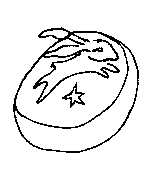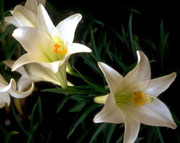Hollow | Legend | Facts | Halloween | Allies | Book | Spring | Friends | Mushrooms | Angel | Treasures | Play | Mail
Easter is actually a lunar festival rather than a solar event. The celebration of Easter falls on the first Sunday after the first full moon on or after the vernal equinox (and if said full moon falls on a Sunday, then Easter is the Sunday after).
In German mythology, she is also the goddess Ostara, the maiden, and celebrated at the Equninox when night and day are equal and balanced. Interestingly, the word "estrus" is also derived from Eostre, for her consort was a rabbit, also a symbol of fertility! We can always use this time to embrace Eostre's energy and look forward to new ideas, new jobs, new goals. According to legend, Eostre became angry with the rabbit and cast it into the heavens. Today we can see the constellation Lepus the Hare, at the feet of Orion.
Eostre gave Lepus the gift of laying eggs once a year, which, combined with the celebration of Christ's resurrection, is why we have the modern day tradition with the Easter Bunny delivering Easter eggs. From the most ancient times, the goddess Eostre was the measurer of time. Our measurer of time is the moon, chosen over the Sun, so the lunar month of 28 days (four weeks of seven days each) gives 13 periods in 364 days, equivalent to the solar year of 52 weeks. The moon may then be another name for Eostre, and its name comes from the Sanskrit word "mas" ~ from ma, to measure ~ and was masculine. Because the measurement of time is an active process, the waxing and full moon was considered male, while the waning and new moon were said to be female. In mythology, gods and goddesses were androgynous and their sex depended upon what was needed in the moment. And, it was believed that a rabbit could change its sex ~ like the moon.
According to tradition, the Jade Rabbit pounds out medicine for the gods with the lady Ch'ang-e. Others say that the Jade Rabbit is a shape assumed by Ch'ang-e herself.
There are even more explanations accounting for the rabbit/moon connection. One is that the bunny is nocturnal and feeds by night; another is that the rabbit's gestation period is one month long. Hares are born with their eyes open, so the Egyptians called the hare "Un," which meant open, to open, the opener. Un also meant period. Thus the rabbit became a symbol for the lunar cycle. The hare as "opener" symbolized the new year at Easter, fertility, and the beginning of new life. The Rabbit's association with the moon is explained by this story.
History
of the
More on
Australia's Easter Bunny Delicious
Idea!
Read more about
Find
in the Heavens Learn more about |
and ...
Site where you can email the Easter Bunny, EasterBunnys.net
Site where you can send free Easter e-cards, Easter-Greetings.net
Site with more free Easter e-cards, Easter-Cards.com
Additional Easter e-cards, jokes, recipes and links at Easter-ecards.com
Even more free Easter e-cards at Easter-egreetings.com
Easter e-cards, activities, screensavers, coloring pages at americangreetings.com
Site
with Easter recipes, jokes, free Easter e-cards
and more on Easter's history and mythology, 101
Easter
*Graphic
credit: "Eostre" painting |












